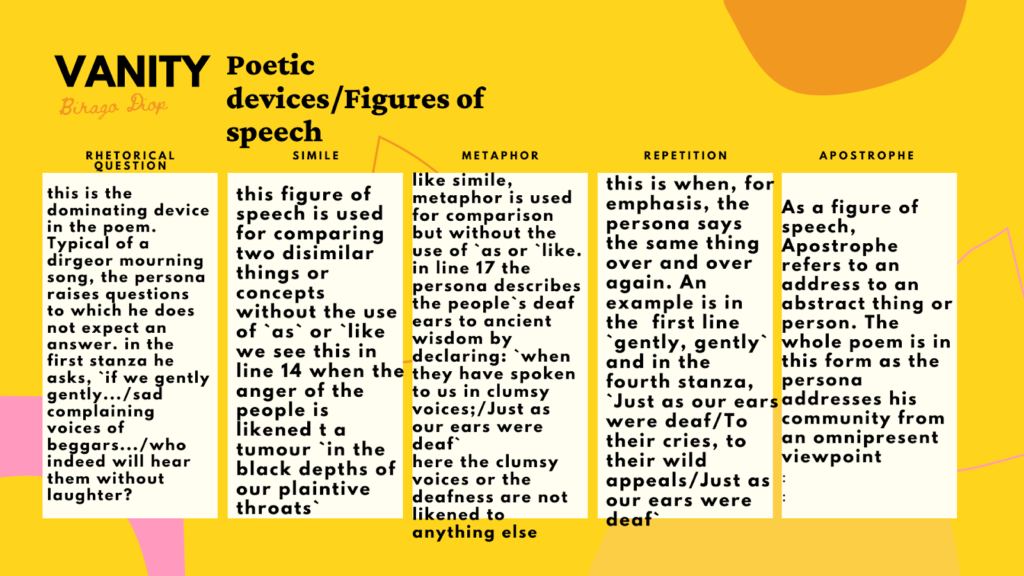Birago Diop, a Senegalese poet and storyteller, is renowned for his powerful use of language and his exploration of African culture and traditions through literature. His works often reflect the rich oral history of African societies, and his storytelling is rooted in a deep understanding of both African and European literary traditions. One of his most notable poems, “Vanity,” exemplifies these themes, offering readers a profound reflection on human nature, materialism, and the fleeting nature of life. In this article, we will provide a comprehensive analysis of “Vanity,” focusing on the background of the poem, its key plot details, and the settings. We will also suggest class activities and assignments that will help readers engage with the poem in a deeper, more meaningful way.
Background to the Poem “Vanity” by Birago Diop
Birago Diop was born in 1906 in Senegal and was an important figure in the negritude movement, a literary and ideological movement that sought to assert the value of African culture in the face of colonialism. His writing often combined elements of traditional African folklore with modern poetic forms, creating a unique blend of storytelling that resonated with both African and Western audiences. Diop’s works, including “Vanity,” often delve into themes such as identity, spirituality, and the relationship between humans and the natural world.
“Vanity” is a poem that encapsulates many of these themes. The poem critiques human behavior, particularly the obsession with superficiality and material wealth, highlighting the futility of these pursuits in the face of life’s inevitable end. Through vivid imagery and poignant metaphors, Diop invites the reader to reflect on the meaning of life, the importance of humility, and the transient nature of human existence.
Summary of “Vanity”
In “Vanity,” Diop explores the theme of human pride and the pursuit of material gain. The poem presents an allegory that contrasts the ephemeral nature of vanity with the enduring essence of the soul. The central figure of the poem is a person who is deeply invested in worldly possessions and status, represented through imagery of beauty and wealth. The speaker critiques this obsession with outward appearance and materialism, emphasizing how such pursuits ultimately lead to emptiness and despair.
The poem is structured around the idea that human beings tend to focus on external appearances, failing to recognize that these pursuits are transient and meaningless in the grand scheme of life. The speaker urges the reader to look beyond the surface, suggesting that true fulfillment and meaning come not from vanity but from a deeper understanding of oneself and the world.
Key Plot Details of the Poem
“Vanity” is not a narrative poem with a traditional plot, but it is an exploration of a central idea: the fleeting nature of human pride and the emptiness of materialistic pursuits. Through Diop’s use of vivid imagery and symbolism, the poem paints a portrait of a person whose focus on vanity leads to their downfall. The central theme revolves around the idea that, despite the societal emphasis on wealth and status, these pursuits are ultimately hollow and unsatisfying.
The poem employs several metaphors and symbolic references to beauty, wealth, and the pursuit of external validation. Diop uses these symbols to contrast the superficial nature of these desires with the more meaningful aspects of life, such as spirituality, humility, and self-awareness. Throughout the poem, there is a clear call to move away from the pursuit of vanity and instead seek a deeper connection to one’s true self and the world around them.
Settings of the Poem
The setting of “Vanity” is not tied to a specific physical location but instead takes place within the mind of the individual. The poem’s setting is metaphorical, focusing on the internal world of the person obsessed with vanity and materialism. This internal setting serves to highlight the emotional and psychological consequences of living a life centered on superficial desires.
Through the poem’s symbolic language, Diop encourages the reader to consider not only the external world but also the inner landscape, where true meaning and fulfillment reside. The setting, therefore, reflects the tension between outward appearances and inward truth, a tension that lies at the heart of the poem’s message.
Class Activities Based on “Vanity”
- Symbolism Exploration: Ask students to identify and analyze the various symbols used in “Vanity.” Have them create a chart that connects each symbol to the poem’s themes. For example, they could analyze how beauty, wealth, and pride are represented through metaphors and what these symbols signify about human nature.
- Group Discussion on Materialism: In small groups, have students discuss how the theme of vanity and materialism is relevant in today’s world. They can reflect on modern-day examples of vanity and compare them to the ideas presented in the poem. Encourage students to share their thoughts on the impact of vanity on individuals and society.
- Poetry Recitation and Analysis: Assign students to memorize and recite a portion of the poem. Afterward, they should write a brief analysis of the lines they chose, discussing how the poem’s language and imagery convey the central themes. This activity will help students engage with the poem on a personal level.
- Create a Visual Representation of the Poem: Have students create an art project or collage that visually represents the themes of “Vanity.” This could include images or symbols that reflect the poem’s exploration of materialism, pride, and the search for meaning. Students can present their visual representations to the class and explain how their artwork connects to the poem.
- Write a Personal Reflection: Ask students to write a reflection on how the themes of “Vanity” apply to their own lives. They should consider how society’s emphasis on appearance and material wealth affects their own attitudes and behaviors. This activity will encourage introspection and deeper engagement with the poem’s message.
Class Assignments for “Vanity”
- Essay on the Theme of Vanity: Have students write a 2-3 page essay analyzing the theme of vanity in the poem. They should explore how Diop uses literary devices such as symbolism, imagery, and metaphor to communicate his message. Students should also discuss the relevance of this theme in contemporary society.
- Research Paper on Birago Diop’s Literary Contributions: Ask students to research Birago Diop’s life and career, focusing on his contributions to African literature and the negritude movement. They should write a paper discussing how Diop’s background influenced his poetry and the themes he explored, including the themes in “Vanity.”
- Compare and Contrast: Assign students to compare “Vanity” with another poem that explores similar themes, such as materialism or the transient nature of life. Students should write a comparative analysis of the two works, discussing the similarities and differences in how the theme is developed.
- Poetry Analysis Assignment: Ask students to choose another poem by Birago Diop or another African poet and write an analysis focusing on the use of poetic devices and the central themes. This assignment will allow students to explore the diversity of African poetry and its treatment of themes like identity, pride, and materialism.
- Creative Writing Assignment: Have students write a poem that explores the theme of vanity in their own lives or in the world around them. They should use literary devices like metaphor and symbolism to convey the fleeting nature of vanity. Students can share their poems with the class and reflect on the similarities and differences in their approaches to the theme.
Conclusion
Birago Diop’s “Vanity” is a powerful and thought-provoking poem that critiques the emptiness of materialism and the superficial nature of human pride. Through his use of vivid imagery, symbolism, and metaphor, Diop urges readers to look beyond the pursuit of worldly possessions and focus on the deeper, more meaningful aspects of life. This poem not only provides valuable insights into the human condition but also serves as a reflection on the societal values that shape our desires and actions. By engaging with “Vanity” through the suggested activities and assignments, students can gain a deeper understanding of the poem’s themes and how they relate to their own lives and the world around them.

